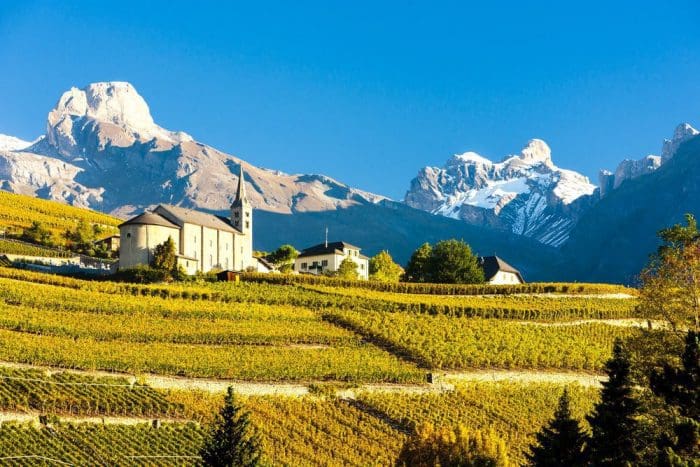Valais, the third largest canton in Switzerland, is located in the southwest of the country. In the south and west, separated by the highest mountains in Europe, it borders on France and Italy.
The canton consists mainly of the wide Rhone Valley, where the larger cities are located, small side valleys and high Alpine peaks. The area is packed with natural wonders, an Eldorado for outdoor lovers. There are 45 four-thousand-meter peaks in the canton. One of them, the Dufourspitze, which with 4634m.a.s.l. is not only the highest mountain in Valais but also in the whole of Switzerland.
Matterhorn / Zermatt

Much more popular and well-known is the 4478m high Matterhorn, the world-famous landmark of Switzerland. This peak towers over the mountain village of Zermatt, in the very south of Matter Valley and a visit should be on the top of your things to do in Valais list. The car-free resort town is a popular destination for both, hiking in summer and skiing in winter.
You can also ski here in summer as it is the highest ski resort in Switzerland. It offers 2400 kilometers of slopes and views of the Matterhorn, and it is open all year round. Zermatt offers further superlatives: at 3883m.a.s.l. lies the “Matterhorn Glacier Paradise”, Europe’s highest mountain station, with the highest glacier palace in the world and a stunning mountain panorama of the Italian, French and Swiss Alpine giants.
On the Gornergrat, opposite the Matterhorn Mountain, you will find Europe’s highest hotel, the 3100 Kulm Hotel. To get to this fantastic 360 platform, you will have to ride Europe’s highest cogwheel railroad. From here you can admire several of the highest peaks of the Alps as well as close by Gorner Glacier, the 2nd biggest alpine Glacier.
Aletsch Glacier

Another must-see location in Valais is the Aletsch Glacier, the largest glacier in the Alps. It still has a length of almost 20km and is up to 800m thick, but thanks to climate change the ice is disappearing faster and faster. High above the Fiescher Valley, you can reach this natural wonder from the car-free vacation villages of Bettmeralp, Fiescheralp and Riederalp in about an hour’s hike.
Perhaps the most breathtaking hike in the Valais is the Aletsch Panorama Trail, which leads for kilometers along the glacier and crosses also its gorge via an impressive suspension bridge. Since 2001, the ice giant has been the center of the 824m2 UNESCO World Heritage Site “Swiss Alps: Jungfrau – Aletsch”, the first ever Alpine natural heritage site.
In hiking distance from the famous Aletsch Glacier you will find its unknown “smaller brother”, the Fiescher Glacier. The third biggest Glacier in the Alps is often forgotten but is hiking alongside its gorge another great activity in the Fiesch Valley.
Rhone Glacier
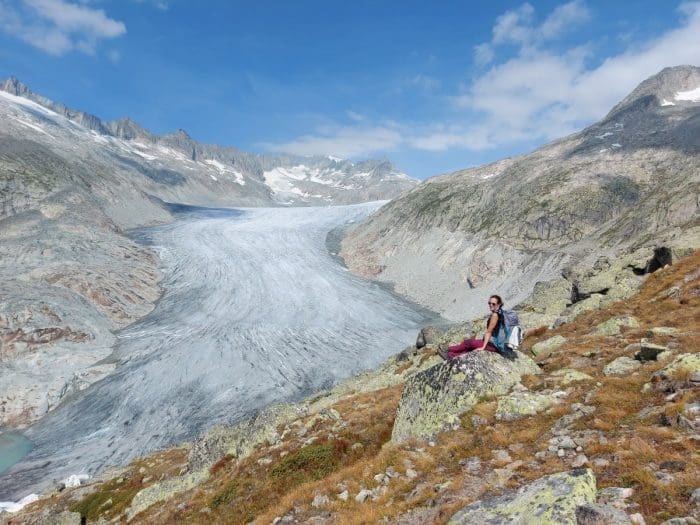
Even easier to reach, since you can almost drive up to it by car, is the Rhone Glacier. This natural wonder gave its name to the largest valley in the Valais. Currently it still has a length of 8km but it is rapidly melting and will no longer exist in 80 years. Via the legendary, curvy road to the Furka Pass, the connection to the canton of Uri, you reach the abandoned Belvedere Hotel and from there in 10 minutes the viewpoint over the glacier. The winding pass road is well-known through the James Bond film “Goldfinger” from 1964 with Sean Connery.
Sion – Capitol of the Valais
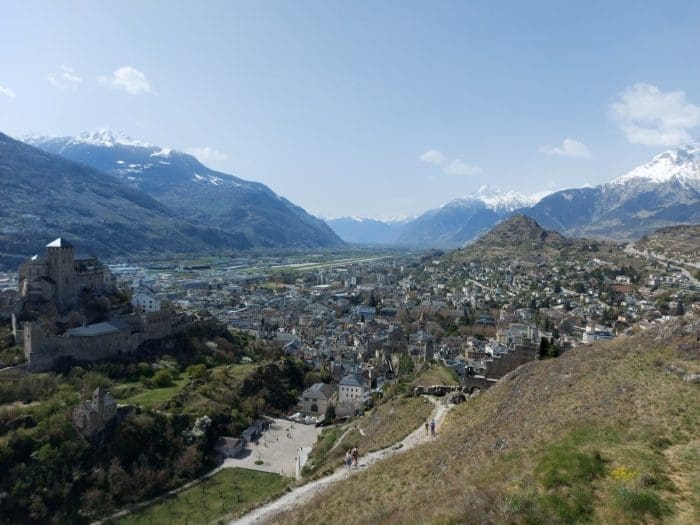
The area known as Valais becomes accessible from its main entry point which is located in the valley town known as Sion. The linguistic areas of Valais separate into French-speaking regions in the western parts and German-speaking areas toward the east. Both Sion serves as a bilingual center while situated exactly on the border between French and German language Switzerland. From this advantageous location people can see two spectacular castles in the distance across the valley panorama.
The ruins of Tourbillon Castle and Chateaux Valère are perched on small hills above the medieval old town, which is one of the best preserved in Switzerland. The castles offer beautiful views into the valley, on the river Rhone and the town of Sion. Apart from the fantastic views from the castle complex of Valère, you will find here in an old church, the oldest playable organ in the world.
Great Saint Bernard Pass – Saint Bernard dogs
The canton of Valais is also famous for its Saint Bernard dogs.
Augustinian monks have bred these dogs at their hospice on the Great Saint Bernard Pass since the Middle Ages.In the past, they used the animals as rescue and avalanche dogs. Today, people primarily use the dogs for therapy.
Hiking along Bisses
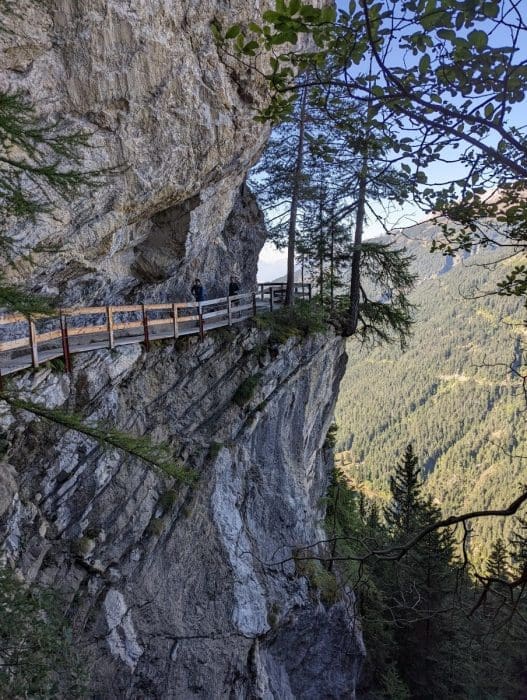
Whoever travels through the Valais will encounter them everywhere: the Bisses (in French) or Suonen (in German), the historic water channels of the canton. Already in Roman times, builders constructed these open ditches to transport water from the mountains into the dry Rhone Valley. Some of them are still used for their original purpose; others serve today as an attraction along the many hiking trails. Some of the waterways lead spectacularly over wooden bridges cut into the rock (e.g. Bisse du Ro) or as a small river course idyllically next to the trails as at the beautiful Bisse du Vex. In total there are 600km of these unique, historic water channels in the Valais.
Lakes in Valais
In the far north of the canton, Valais has access to one of the largest lakes in Europe, Lake Geneva. This international body of water is the largest lake in both Switzerland and France. It offers many beautiful swimming beaches, countless water sport options and boat trips with gorgeous views of the impressive surrounding Alps.
Alternatively, the St. Leonard Grotto, between the valley towns of Sion and Sitten, is home to the largest known underground lake in Europe. The caves have only 15 degrees and you are not allowed to swim here. Only with a guided boat tour you can explore the over the 6000m2 underground lake.
Vineyards in Valais
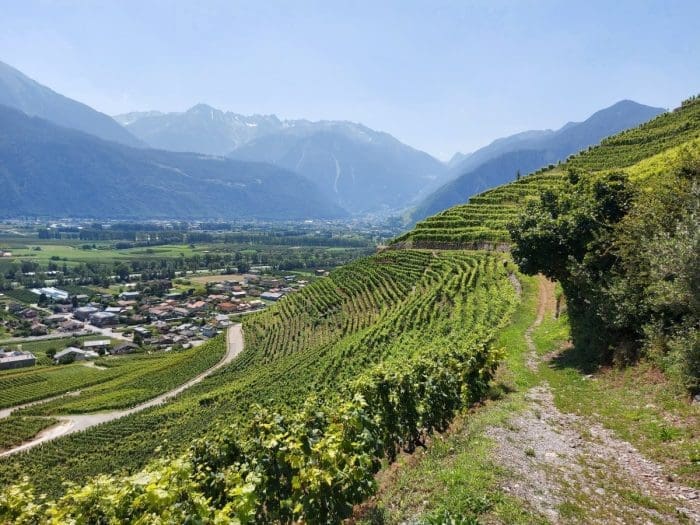
Various regional vineyards offer wine and local food tastings. There are also beautiful hiking trails that crisscross the Valais through the vines.


